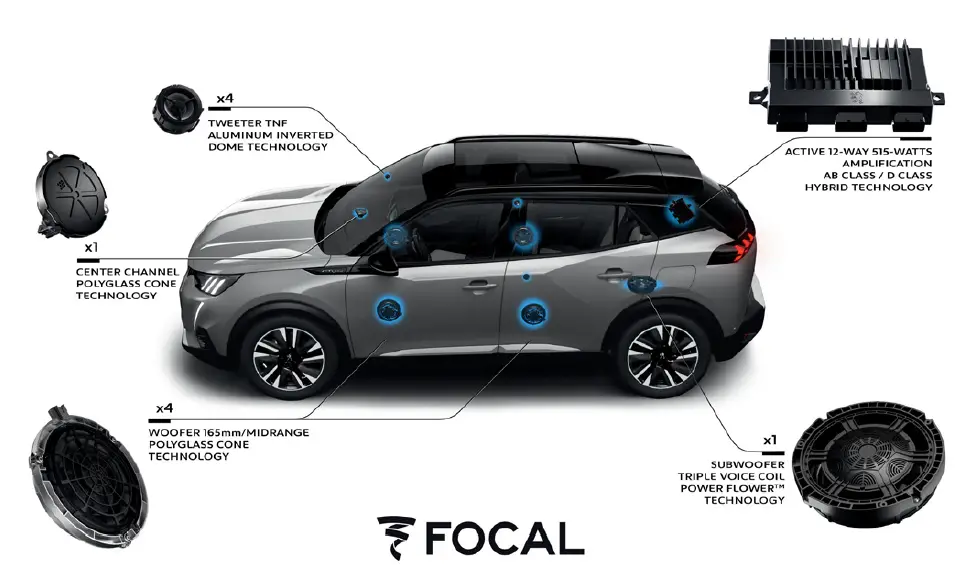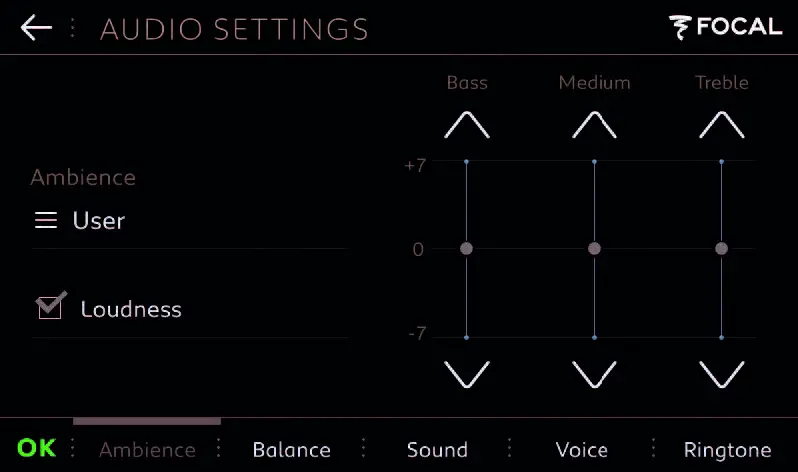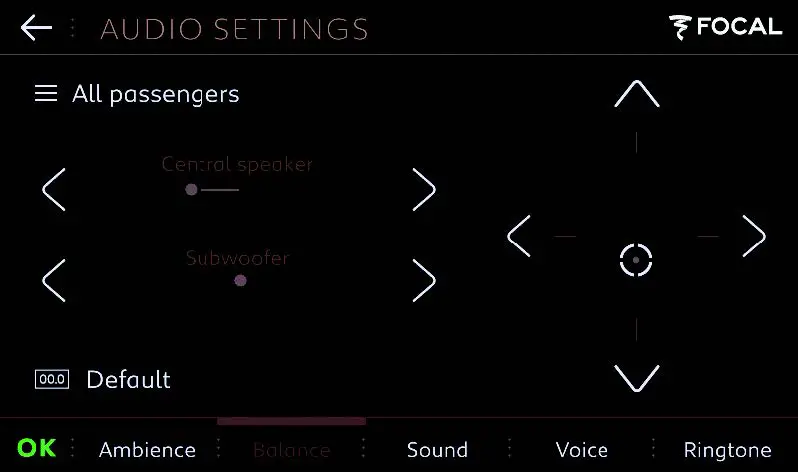INTRODUCTION
FOCAL and PEUGEOT wanted to redefine the codes of Hi-Fi car audio together by offering unique and unprecedented sounding performances, following the Focal motto… After the Peugeot 3008/5008 SUVs and 4008 in China, the recent Peugeot 508, 508SW and 508L family, the all new Peugeot 2008 versatile SUV also provides the french premium acoustic savoir-faire of Focal. Thanks to the resolutly high-end revisited Peugeot i-Cockpit® and to the use of exclusive technologies that made the Hi-Fi Premium Focal® a success in the previousvehicles, the brand new Focal audio system goes beyond the limits of comfort, for an intense and multi-sensory driving experience. Thank you for choosing Focal for your Peugeot car audio system. Welcome to our High-Fidelity world. Innovation, tradition, excellence and pleasure are our values; our one and only aim is to bring you a sound that is rich, pure and true. To make the most of your Hi-Fi system’s functions and to enjoy its performance to its full potential, or to customise it according to your personal taste, we recommend that you read the instructions in this manual thoroughly. Refer to this manual in future if you encounter any problems.
The new PEUGEOT 2008 SUV is equipped with a high-fidelity sound system created by FOCAL, a specialist in the acoustics sector for more than 40 years and known worldwide for its patented innovations and unique sound signature. 10 speaker drivers featuring exclusive FOCAL technologies offer the pleasure of pure and detailed sound for your vehicle:
- High-fidelity woofer/midrange drivers: Polyglass technology guaranteeing balance and precision.
- TNF tweeters: aluminium inverted dome technology offering optimal sound dispersion and very detailed treble.
- Subwoofer: 77/8″ (200mm) subwoofer with triple Power Flower™ voice coil for dynamic and precise bass.
- Active 12-way 515W amplifier: hybrid Class AB/Class D technology delivering rich and smooth treble and really powerful bass.

A FEW WORDS ON FORMAT QUALITY USB SOURCE
The audio industry has been witnessing a digital revolution for the past twenty years. For many years, quantity has been valued over quality. The low speed of internet connections, combined with the high cost of storing considerable amounts of data resulted in the development and widespread use of a compressed audio format, MP3. Despite its obvious ease of use, MP3 compression also resulted in a partial loss of some data contained in the audio files: reduced frequency range (less bass and treble), digital noise, loss of dynamic range (the music is less lively and less impressive). Here are a few basic notions on the quality of the different audio formats available (kbps = kilobits per second):
- Low quality: MP3 files encoded at a bit rate of under 256kbps (for example 96kbps / 128kbps).
- Medium quality: MP3 files encoded at a bit rate of between 256 and 320kbps. An MP3 encoded at a bit rate of 320kbps is already sufficient for listeners to take advantage of the FOCAL Premium Hi-Fi system.
- ‘Lossless’ quality: 44.1kHz / 16 bit WAV files or 44.1kHz / 16 bit FLAC files. These formats offer quality identical to that of CDs.
- High-resolution: 192kHz / 24 bit WAV or FLAC files. These formats have only started to emerge over the last few years and require very high-quality hardware. This format allows listeners to enjoy the live studio quality of the album’s original recording.The multimedia system of your Peugeot 2008 SUV also decodes lossless files and high resolution tracks in WAV of FLAC formats, you can enjoy your existing lossless music library.

- Use files which are encoded at a minimum bit rate of 320kbps, and make sure that you trust the origin of the original files.
- Ideally, use 16 bit / 44.1kHz FLAC files or 16 bit / 44.1kHz WAV files.
ABOUT CONTENT PLAYBACK STREAMING AND BLUETOOTH®
Note:
- From the Apple IOS 11 FLAC files are decoded
- The iPhone X, iPhone 8, iPhone 8 Plus and iPhone 7 are FLAC compatibles.
- The iPhone 6, iPhone SE and iPhone 5S are WAV compatibles.
Please note that these basic notions on audio format quality are also valid for online music streaming platforms. Listening to songs via these types of platforms inevitably entails limitations in terms of bit rate. Contact your streaming platform for advice on the actual bit rate available with your subscription and the subsequent audio quality.In addition to the compression of the source MP3 files (data compression), the wireless function of some devices may also result in some compression (wireless or Bluetooth® connectivity for example), even if they are very practical solutions. Thus, subsquent losses in quality are sometimes accumulated as early as the source and this is irreversible. The Hi-Fi Focal system for your Peugeot 2008 SUV has been designed and developed to reproduce every tiny detail and to provide dynamics which reflect the artist’s initial intention, without compromise. We advise that you pay attention to the quality of your audio files and how you play them, in order to enjoy the full experience; the way everyone involved in the process of its creation (musicians, sound engineers, producers) intended you to hear it. Beyond the quality of the audio stream or the source files, the means of playing the music may also have a significant impact on the final audio quality.
Despite all of the improvements made to Bluetooth® technology these past few years, (aptX for example), this technology will only achieve a quality equivalent to MP3 files encoded at a bit rate of 320kbps, regardless of the quality of the audio file on your smartphone.
In summary, here is some advice to help you make the most of your FOCAL Premium Hi-Fi system:
- If possible, use a USB device in order to avoid any subsequent compression with Bluetooth®.
- To decode your smartphone files, use the CARPLAY and ANDROID AUDIO wired technologies, offering a better sound quality than Bluetooth®
- When listening to the radio, DAB is preferable (if available in the region), as it offers better quality than FM.
- If you have a subscription to a music streaming platform, choose the better quality, high-speed offers rather than others on the market which result in destructive file compression.
ACCESSING AUDIO SETTINGS
In order to access the audio settings, on the screen showing the device currently playing, press OPTIONS:
Then press, Audio settings: Please note that the audio settings are specific to each media source used.
The Audio settings screen will be displayed with two main panes: Ambience and Balance.
NOMINAL SETTINGS FOR FOCAL’S SOUND SIGNATURE
The system’s default settings are configured with the nominal settings and with the Loudness on, see below:
AMBIENCE SCREEN:
- Ambience EQ: User
- Loudness on: As this is dynamic, its correction evolves depending on the car’s speed, making it possible to stabilise the perceived volume when accelerating or braking, but also to compensate for natural variations in hearing due to equal-loudness contours.
- Bass / Medium / Treble equaliser: 0 (centred).
BALANCE SCREEN:
- All passengers, if there are several passengers in the car.
- Driver, if you are alone.
- Central speaker driver level: 0 (centred).
- Subwoofer level: 0 (centred).
- Fader / Balance: 0 (centred).
With these settings, the goal of the FOCAL sound signature is to offer three key criteria to the car audio experience:
- Equalisation specific to the FOCAL brand: very precise and detailed treble. present but controlled bass, very clear vocals.
- A system which doesn’t generate imperfections, regardless of the style of music or the volume.
- A stable soundstage for all five seats, in order to reproduce a faithful soundstage comparable to that of a classic Hi-Fi home audio system.Nevertheless, listening to a Hi-Fi system is a question of personal taste, there are no set rules. The sound of a car audio system may also differ depending on the use. This is why FOCAL and PEUGEOT wanted every driver to be able to customise their Hi-Fi experience according to their personal tastes, using the multimedia interface. The following paragraphs describe how the settings work and the effects to expect. It is also a good opportunity to give users some advice on how to enrich their Hi-Fi experience and how they can adjust the settings according to their expectations.
HCI INSTRUCTIONS
AMBIENCE SCREEN:By pressing Ambience, you can choose the type of spectral balance. The User mode corresponds to a setting which can be adjusted using the three frequency ranges Bass/Medium/Treble.
In addition to the User ambience which enables you to customise you own setting, five pre-set ambiences are also available and accessible via the drop-down menu:
- Classical
- Jazz-Blues
- Pop-Rock
- Techno
- Vocal
 For reference, here are the spectral corrections applied for each of the pre-set ambiences:
For reference, here are the spectral corrections applied for each of the pre-set ambiences:
BALANCE SCREEN:By pressing ‘All passengers’ (default setting), you will access the drop-down menu with the pre-defined audio balance settings.Caution: these settings are different to the ‘Balance’/’Fader’ buttons located on the right of the screen.
There are three pre-defined Balance settings which are accessible via the drop-down menu:
- All passengers
- Driver
- Front only
ALL PASSENGERS
This is the recommended mode for when there are several passengers in the vehicle. Audio settings are optimised so that all the passengers simultaneously benefit from the best sound image and texture.

DRIVERThis is the recommended mode for when the driver is alone in the car. Audio settings are optimised for positioning the sound image and balance around the driving seat. Note that the others passengers won’t benefit from the full potential of the system when this mode is activated.


FRONT ONLYThis mode is similar to ‘All passengers’ mode but with all the rear speaker drivers deactivated. This mode allows you to quickly reduce the volume at the rear, while keeping symmetrical and nominal audio up front.
OPTIMISATION – GOING ONE STEP FURTHER
INCREASING SOUND IMMERSION:Some people are particularly sensitive to the distribution of power and prefer considerable sound immersion.

It is possible to customise FOCAL’s nominal sound signature in order to achieve this:
- Reduce the power of the central speaker driver using the slider on the Balance screen, by moving it one or two notches to the left.
- Moving the fader towards the back by one or two notches (the two arrows on the picture of the seats on the Balance screen representing the displacement of power) will reduce the power coming from the central speaker driver even more, providing more enveloping sound.



- You can additionally reduce the Medium by -1 notch on the equaliser in User mode.We recommend this type of setting when listening to very monophonic radio stations, for example.
LESS IMMERSION/A VERY FRONTAL SOUNDSTAGE
On the other hand, some people prefer very ‘Hi-Fi’ sound, with a frontal soundstage, where the position of the instruments and voices is very precise and very focused.

It is possible to customise FOCAL’s nominal sound signature in order to achieve this:
- Increase the power of the central speaker driver using the slider on the Balance screen, by moving it one or two notches to the right.
- Move the fader towards the front by one or two notches (the two arrows on the picture of the seats in the Balance screen representing the displacement of power).



Focal-JMlab® – BP 374 – 108, rue de l’Avenir – 42353 La Talaudière cedex – FranceTél. (33) 04 77 43 57 00 – Fax. (33) 04 77 37 65 87 – © 2017 Focal-JMlab® – SCAA -180516/3 – PCXXXXDue to constant technological advances, Focal-JMlab® reserves its right to modify specifications without notice. Images may not conform exactly to specific product – Photos L’Atelier Sylvain Madelon.
[xyz-ips snippet=”download-snippet”]

